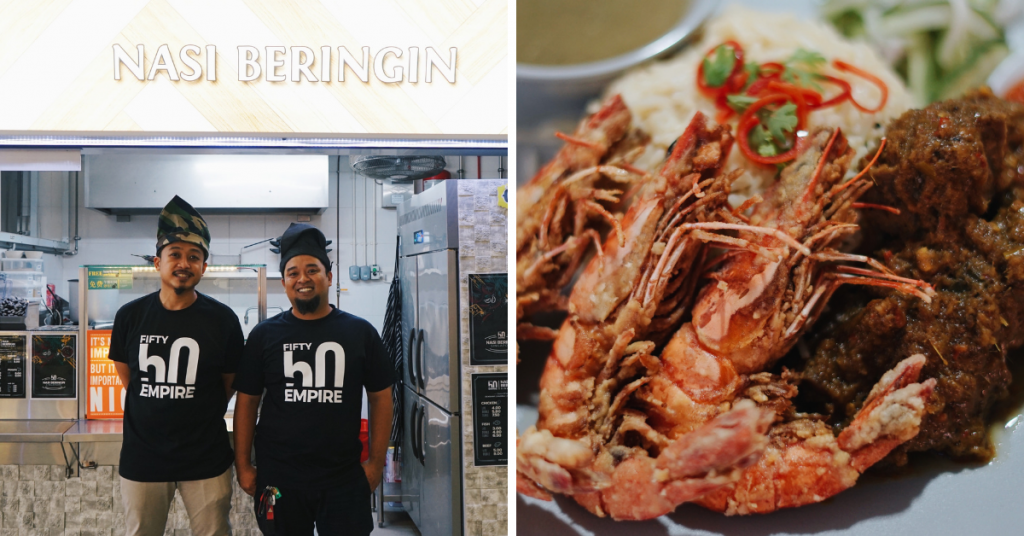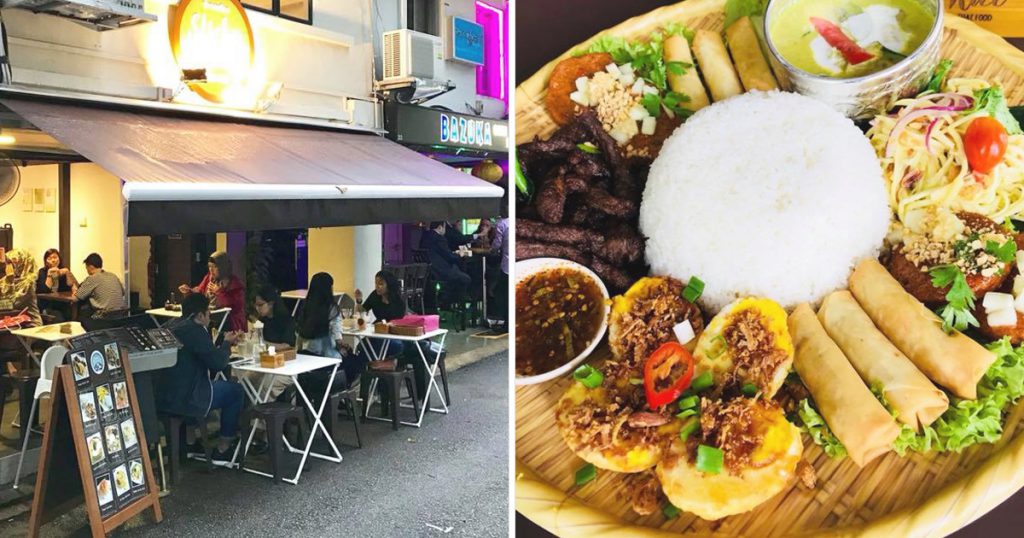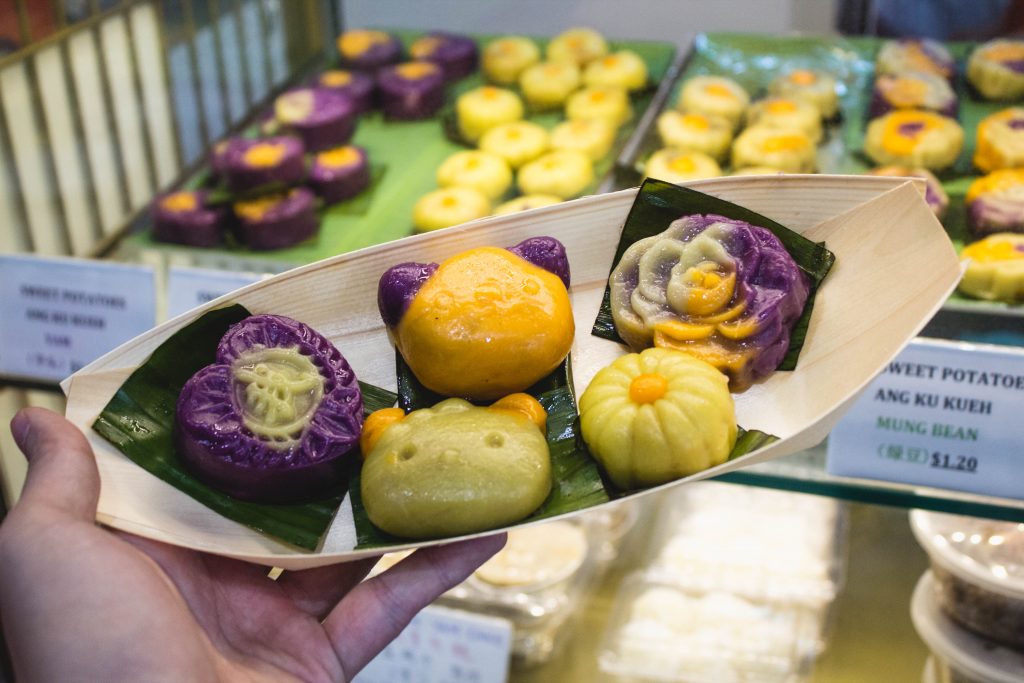Long-Lost Malay Dish ‘Nasi Beringin’ Revived At Yishun: It Was Once Served To Royalty In The 1890s

One would typically associate Malay food with Nasi Lemak, Mee Rebus, Nasi Padang etc.
However growing up as a Malay in Singapore, most of us would probably have never heard of this Malay dish called Nasi Beringin.
This Malay dish was once sold in Singapore for a short period of time in the 1950s but gradually disappeared from the local Malay food scene.
Chef Fahmi Rahaman decided to revive this long lost Malay dish that was once served to the Johor Royalties in the late 1890s.
[caption id="attachment_37556" align="aligncenter" width="5588"] (L) Khairul Afnan (R) Fahmi Rahaman | Image Credit: Discover SG[/caption]
(L) Khairul Afnan (R) Fahmi Rahaman | Image Credit: Discover SG[/caption]
Reviving A Long Lost Dish
Introduced in the late 1890s, Nasi Beringin was first popularised within the compounds of the Johor Royalties. Sultan Sir Ibrahim, then the 2nd Sultan of Johor in the modern era, regularly had this dish in his feasts especially when guests were invited to dine in the palace.
Nasi Beringin, was also called the “Nasi Bering Harum” (Fragrant Beringin Rice), as the scent from the dish never fails to invigorate one’s palate.
[caption id="attachment_37554" align="aligncenter" width="6000"] Image Credit: Discover SG[/caption]
Image Credit: Discover SG[/caption]
Owner of Fifty50 Empire, Fahmi Rahaman who was an ex Assistant Head Chef with Timbre Group recently set up stall at Yishun Park Hawker Centre together with his partner, Khairul Afnan selling Nasi Beringin.
Nasi Beringin is served with traditional favourites such as the Ayam Kurma, Rendang, and Achar which combines all the sweet, sour, spicy and savoury elements into a harmonious unity within a plate.
At Fifty50 Empire, you are given a wide range of meat to choose from – Fried Chicken Wing (Signature), Fried Fish, Beef Rendang, Tiger Prawn, Fried Squid which comes in various portion size (lite, double, triple).
[caption id="attachment_37549" align="aligncenter" width="6000"] Image Credit: Discover SG[/caption]
Image Credit: Discover SG[/caption]
They also provide three different sauces – rendang, kurma and masak merah. The sauces are really unique as they were taught to him by his mother.
If you’re wondering how Nasi Beringin tastes like, its basically a cross between Nasi Lemak and Nasi Briyani. Fahmi uses short grain basmati rice that is cooked with a variety of spices and oil resulting in rice that’s temptingly fragrant. Delicate hints of cardamom, cloves, star anise and fenugreek can be discerned in the rice.
[caption id="attachment_37551" align="aligncenter" width="6000"] Image Credit: Discover SG[/caption]
Image Credit: Discover SG[/caption]
The prawns were definitely the star of the entIre dish. The prawns were fresh and battered to give it a slight crunch. We recommend pairing the Prawns with Masak Merah Sauce.
[caption id="attachment_37553" align="aligncenter" width="5531"] Image Credit: Discover SG[/caption]
Image Credit: Discover SG[/caption]
The chicken wing was as impressive as the prawns. Instead of coating the chicken in a thick batter, the wings are lightly coated with flour and his blend of spices before frying. This makes a lot of difference to the chicken as the batter won’t soak up the oil and this also keeps it crispy.
[caption id="attachment_37555" align="aligncenter" width="5358"] (L) Kurma Sauce (R) Masak Merah Sauce | Image Credit: Discover SG[/caption]
(L) Kurma Sauce (R) Masak Merah Sauce | Image Credit: Discover SG[/caption]
If you’re looking for a traditional way of eating Nasi Beringin, we highly recommend pairing the Chicken with Kurma Sauce which is made from coriander, cumin, coconut, curry and chili.
[caption id="attachment_37552" align="aligncenter" width="6000"] Image Credit: Discover SG[/caption]
Image Credit: Discover SG[/caption]
The Beef Rendang is another favourite of Fahmi’s. The beef was tender and tore apart easily. I also liked the fact that the rendang was the perfect balance of sweet and spicy.
Each plate of Nasi Beringin comes with sambal belacan for the extra kick, achar to cut the acidity of the dish as well as a crispy piece of papadum.
As compared to Malay dishes such as Nasi Lemak and Nasi Padang which can be pretty heavy as a lunch option, the Nasi Beringin did not leave me with a food coma.
If you’re ever in Yishun, and looking for a change from your typical Malay fare, you know where to go for a good meal.
Fifty50 Empire Nasi Beringin
Address: 51 Yishun Avenue 11, Singapore, 768867
Opening Hours: 11am to 9pm daily. Closed for Friday Prayers from 1pm- 2pm
Website
Also Read [REVIEW] We Spent $5.90 On LiHo’s New Salted Egg Bubble Tea So You Don’t Have To
(Header Image Source: Discover SG)
This Aroi Mak Nasi Ambeng Swaps Rendang And Achar For Green Curry And Mango Salad

As a proud Malay millennial, I get extremely excited when I hear these two words: “nasi” and “ambeng”.
Nasi Ambeng (pronounced Nasi Um-Bng) is a classic Javanese dish that is usually shared between 3 to 4 people.
The dish consists of a mountain of rice in the middle of the platter, surrounded by other traditional Javanese dishes such as ayam masak lemak, fried tempeh, begedil, urap, sambal goreng and beef rendang (which is technically Minangkabau but let’s not get into that).
You’ll find plenty of restaurants serving this traditional dish. However, the version at Sticky Rice stands out from the rest with their Thai Style Nasi Ambeng.
Old Dish, New Flavours
The Rice Platter ($28.50), as the Nasi Ambeng dish is named at Sticky Rice, comes with a generous portion of fragrant steamed white rice, fried beef strips, mango salad, fish cakes, spring rolls, green curry chicken, stir-fried vegetables, and “son-in-law” eggs.
[caption id="attachment_33229" align="aligncenter" width="768"] Image Credit: Sticky Rice Facebook[/caption]
Image Credit: Sticky Rice Facebook[/caption]
If you’re wondering what the “son-in-law” eggs are, you’re not the only one.
This egg dish is also known as Khai Luk Khoei. It’s basically hard boiled eggs that are deep fried so they have a crispy golden skin. It is served with a sweet-sour sauce – made from tamarind and fish sauce.
This Rice Platter also comes with a small bowl of Thai Green Curry, which in my dictionary, is the most essential dish in Thai cuisine. The green curry is mild and light which helps in balancing out the flavours of all the other dishes.
It also comes with a green mango salad which ties the entire dish together with it’s tangy and spicy flavour.
This platter is perfect shared among 2-3 people. If you’re feeling a little peckish, go alone. We dare you.
However, if you’re not looking for a heavy afternoon lunch, you can also opt for the Pad Thai Platter ($28.50) which basically replaces the rice with a mountain of chicken pad thai.
[caption id="attachment_33230" align="aligncenter" width="960"] Image Credit: Sticky Rice Facebook[/caption]
Image Credit: Sticky Rice Facebook[/caption]
This platter comes with a side of omelette strips, crispy chicken skin, prawns, bean sprouts, peanuts, lime and chilli powder. All you have to do is mix everything together and enjoy!
If you’re not up for a huge feast, you can order individual dishes from their menu as well. Best part, they have vegan options for all you vegans out there. Now everyone can enjoy quality food together.
[caption id="attachment_33232" align="aligncenter" width="1600"] Image Credit: @shazzharif[/caption]
Image Credit: @shazzharif[/caption]
We highly recommend you to take a trip to Sticky Rice for a taste of Thailand here in Singapore. Aroi mak!
Sticky Rice
Address: 23 Bali Lane, Singapore 189859
Opening Hours: Mon – Thu: 12pm – 3pm, 6pm – 9.30pm, Fri – Sat: 12pm – 3pm, 6pm – 10.30pm, Closed on Sundays
Contact no.: 6294 0118
Singapore’s First Vegan Ice Cream Joint Takes The ‘Guilty’ Away From Pleasure
(Header Image Source: Sticky Rice Facebook)
These Exotic Ang Ku Kuehs Are On A Kueh-st To Conquer Your ‘grams And Tastebuds

Before all the fad foods that exist today, there were good old traditional pastries like Ang Ku Kueh.
A traditionally red pastry consisting of a sticky, chewy skin, wrapped over a sweet filling, this kueh was a regular feature on the dining table when many of us were children.
Kueh Ho Jiak, which literally translates to ‘kueh nice to eat‘, hopes to bring the humble kueh to the ‘gram-loving, health-conscious generation by changing up its flavours and appearance.
[caption id="attachment_27986" align="alignnone" width="5184"] Kueh Ho Jiak[/caption]
Kueh Ho Jiak[/caption]
Located in the CBD, at Tanjong Pagar Plaza Food Centre, every one of the kuehs here is handmade with love.
[caption id="attachment_27989" align="alignnone" width="1296"] Kueh Ho Jiak storefront[/caption]
Kueh Ho Jiak storefront[/caption]
Think multi-toned kuehs in purple, brown, yellow, and black hues. These kuehs come in a variety of shapes: bear, Hello Kitty, flower, heart, and circle. This facelift feels fresh, while still pointing to the kueh’s traditional roots with the banana leaf at the base of each one!
A Fresh Spin On Kueh
While Ang Ku Kueh skins are traditionally made of glutinous rice flour, the skins of Kueh Ho Jiak’s Ang Ku Kuehs are made of 5 different varieties of sweet potatoes: Japanese sweet potatoes, Purple sweet potatoes, Jewel sweet potatoes, Hannah sweet potatoes, and Garnet sweet potatoes.
The different coloured sweet potatoes are also what give these kuehs their unique hues. No artificial colourings are used in the making of these little snacks!
[caption id="attachment_27994" align="alignnone" width="5184"] Kueh on display[/caption]
Kueh on display[/caption]
Appearance aside, what lies within the skin is even more intriguing. Some of the more unusual flavours include durian ($1.60) and hae bee hiam (spicy dried shrimp) ($1.60). Other flavours you’ll find are mung bean ($1.20), red bean ($1.20), peanut ($1.20), coconut ($1.20), and yam ($1.60).
While hae bee hiam Ang Ku Kueh may sound odd, don’t write it off without giving it a try! Spicy without being overly salty, this is likely to be a winner among those of you who love your savoury foods.
Generally, the kuehs here are less sweet than those you may be used to eating. While this threw us off at first, the more we had of it, the more we grew to like it! The skin of these kuehs is also softer than others we’ve tried – another thing we really like.
The crowd favourite here is the durian Ang Ku Kueh, so make sure to give that a try if they’re available when you stop by!
Made With Love
Everything at Kueh Ho Jiak is handmade with love.
In the evening, the people at Kueh Ho Jiak start making the kuehs. At around 1am, they start to steam them, and at 6am, the kuehs are delivered to the coffee shop to be sold. Some of the kuehs are brought to the store uncooked and are steamed fresh at the store once the previous batch is sold out.
[caption id="attachment_27987" align="alignnone" width="5184"] Kuehs ready to be steamed[/caption]
Kuehs ready to be steamed[/caption]
Aside from Ang Ku Kuehs, some of the other things you must try while you’re here are the Bomb Puffs ($1.50) and the Ubi Kayu (cassava) ($2.20).
[caption id="attachment_27995" align="alignnone" width="5184"] Bomb Puffs[/caption]
Bomb Puffs[/caption]
The Bomb Puff is the bomb. A curry puff with a crispy, fluffy pastry, its filling is chunky and very flavourful. Eating it, you can tell that the people at Kueh Ho Jiak have put a lot of effort into perfecting every element of the puff.
[caption id="attachment_27997" align="alignnone" width="5184"] Ubi Kayu[/caption]
Ubi Kayu[/caption]
The Ubi Kayu here is delicious as well. Served with a fancy pair of toothpicks, these cassava balls are fragrant and so soft, they melt in your mouth!
A New Lease Of Life
Kueh Ho Jiak is all about inventing new recipes and giving traditional kuehs a new lease of life. A novel idea, these photogenic kuehs are sure to capture your heart and tastebuds!
[caption id="attachment_27985" align="alignnone" width="5184"] Kueh Ho Jiak[/caption]
Kueh Ho Jiak[/caption]
Made with no preservatives, no pork, and no lard, you can even request for vegan versions to be made! Every kueh is made using healthy, fresh ingredients, so you can be sure you’re putting only good things into your body.
Looking to get your hands on these goodies? Place an order with Elizabeth at 9028 4359 because the kuehs here tend to sell out quite fast. While officially, Kueh Ho Jiak opens until 2pm, most days, it is closed by noon because it has run out of kuehs to sell!
Affordable, delicious, and so photogenic, you won’t regret trying these little treats!
Kueh Ho Jiak
Address: 6 Tanjong Pagar Road, #02-20 Tanjong Pagar Plaza Food Centre, Singapore 081006
Opening Hours: Mon – Sat: 7am – 2pm; Closed on Sun
Contact no.: 9028 4359
Facebook
Also read We Tried Glamping For The First Time And It Was As Awesome As It Looks





